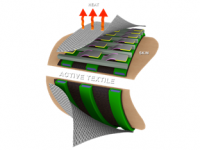Wearable Electroactive Textile

Technology Description:
SRI International will develop a highly efficient, wearable thermal regulation system that leverages the human body’s natural thermal regulation areas such as the palms of the hands, soles of feet, and upper facial area. This innovative “active textile” technology is enabled by a novel combination of low-cost electroactive and passive polymer materials and structures to efficiently manage heat transfer while being quiet and comfortable. SRI’s electronically controllable active textile technology is versatile - allowing the wearer to continue to use their existing wardrobe. We believe that these features will allow for products that augment wearable technologies and thus achieve the widespread adoption needed to save energy on a large scale.
Potential Impact:
If successful, DELTA technology could increase energy efficiency, reduce emissions produced by powering traditional HVAC systems, and enable more sustainable heating and cooling architectures for energy-efficient building design.
Security:
The innovations developed under the DELTA program have the potential to increase energy efficiency, improve overall building performance, and reduce HVAC energy consumption by at least 15%.
Environment:
The heating and cooling of buildings generates about 13% of the U.S. domestic greenhouse gas emissions. With full adoption, DELTA can reduce these emission by 2%.
Economy:
DELTA program innovations can help U.S. businesses eventually reduce reliance on tightly controlled building environments, thus enabling radical and sustainable architecture in next generation energy efficient building designs.
Contact
ARPA-E Program Director:
Dr. Jennifer Gerbi
Project Contact:
Mr. Roy Kornbluh
Press and General Inquiries Email:
ARPA-E-Comms@hq.doe.gov
Project Contact Email:
roy.kornbluh@sri.com
Partners
Stanford University
University of California, Los Angeles
Related Projects
Release Date:
04/29/2014
